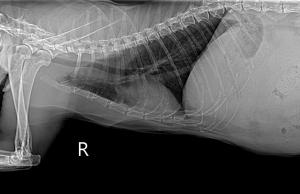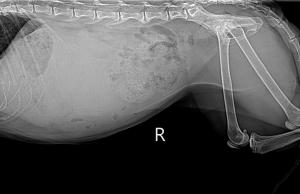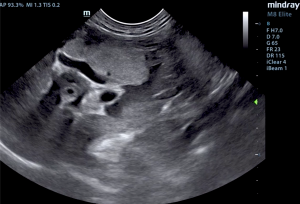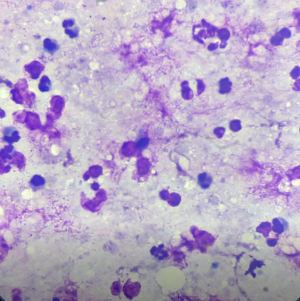Karen Ebersole, DVM, SDEP® certified clinical sonographer/instructor, and owner of Scanvet Mobile Veterinary Ultrasound (which provides services in central Maine, from Portland to Augusta), performed the ultrasound for this month's Case Of the Month. She hit the mark with her fine needle aspirates and processing of her diagnostic slides utilizing telecytology; as we say here at SonoPath, "Nice shootin Tex!". Dr. Ebersole was able to provide the answers needed to her client in order to decide on the best treatment options for this patient. Intepretation of ultrasound images by Eric Lindquist, DMV, DABVP, Cert. IVUSS founder & CEO of SonoPath.com. Cytology read by L.D. McGill, DVM, Ph.D., DACVP.
Sampling
Ultrasound guided FNA of the mass was performed without complication.
DX
Ultrasound: Undifferentiated mass in the region of the pancreas associated with the spleen and caudate liver, deviating the gastrointestinal tract. Cytology: Abdominal mass - Severe chronic suppurative inflammation consistent with an abscess and bacterial infection.
Outcome
The patient is currently being managed with antibiotics and is stable at this time.







Comments
Comments and recommendations from ultrasound: The mass does not appear resectable. It impinges upon the spleen and could be deriving from the spleen, yet would be an odd pattern for a splenic mass. The mass is likely adhesive to the spleen and not necessarily deriving from it. Exploratory surgery could be considered depending upon the results of the FNA. Chronic suppurative necrotic disease possible depending upon cytology results.
Comments and recommendations from cytology: The cellularity in all of these videos supports a rather severe chronic inflammatory process. There are excellent collections of cells that support an abscess. There are even scattered structures that suggest coccobacillus bacteria. There is no suggestion of malignant cellularity in the collection. Treatment with antibiotics and elimination of the mass may be beneficial for treatment in Tank. This easily could be derived from the pancreas but it could be from other sources as well. A guarded prognosis is warranted in these cases of rather severe inflammation in the abdomen of cats. Culture may be beneficial if material is available.